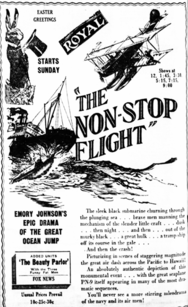The Non-Stop Flight
The Non-Stop Flight is a 1926 American silent Melodrama film directed by Emory Johnson. Emilie Johnson, Emory's mother, wrote both the story and screenplay. The film's "All-Star" cast features Knute Erickson and Marcella Daly.
| The Non-Stop Flight | |
|---|---|
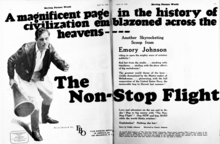 The Non-Stop Flight Magazine Ad | |
| Directed by |
|
| Produced by | Pat Powers Emory Johnson |
| Written by | Emilie Johnson Story and Screenplay |
| Starring |
|
| Cinematography | Gilbert Warrenton |
| Color process | Black and White |
| Distributed by | Film Booking Offices of America |
Release date |
|
Running time | 6 reels 60 minutes |
| Country | USA |
| Language | Silent (English intertitles) |
The film is loosely based on the U.S. Navy's attempt to fly a twin-engine seaplane non-stop between San Francisco, California, and Hawaii. The 1925 flight fell short of its goal. During the trip, the seaplane exhausted its fuel supply. The plane made an Emergency landing in the ocean. Trapped at sea, the crew constructed a sail and set out for Hawaii. The crew endures harrowing adventures and is finally rescued nine days later.
Emilie Johnson built a story revolving around a Swedish sea captain. While he is away at sea, his pregnant wife is kidnapped. Stricken with grief, he turns to a life of crime. While smuggling illicit cargo to Mexico, his tramp steamer chances upon an uncharted island. They discover its only inhabitants are a hermit and a beautiful young woman. Coincidentally, the desperate seaplane crew stumbles upon the same uncharted island. A free-for-all ensues capped with a predictable ending.
The film was released on March 28,1926, by Film Booking Offices of America.[1][2]
Plot
This story starts in 1906, Sweden. A Swedish sea captain, Lars Larson, played by Knute Erickson, leaves his home and embarks upon a long sea voyage. He leaves behind his wife, Anna, played by Marcella Daly. She is pregnant and expecting their first child.
While he is away at sea, life-shaping events take place. A bitter rival abducts Captain Larson's wife. During the kidnapping, he forces Anna Larson to forge a note asserting she is leaving him of her own volition.
Captain Larson returns home from his voyage. He finds his wife missing and his home unoccupied. Larson reads her goodbye note. Enraged, he destroys their home. His transformation begins, fueled by extreme bitterness, turns him into a vicious, drunken ne'er-do-well. He becomes a smuggler. He deals in trafficking illegal cargo, including drugs, and engaging in the slave trade.
We now shift to 1925 - the United States Navy is attempting the first non-stop flight between San Francisco to Hawaii. During the trip, a fuel shortage forces the plane down in the Pacific. Harlan Hilton plays the plane's commander Roger Davis. Cecil Ogden plays the airship's Pilot Lieutenant Jack Connell. Both officers try to keep the crew's spirits and morale at a top-level. They tell the team the battle fleet is searching for them and only a matter of time before the Navy pinpoints their location.
The PN-9 No one airship drifts to a nearby uncharted island. The crew deplanes and travels to the island. They find a hermit Jan Johnson, played by Frank Hemphill and a beautiful young woman played by Virginia Fry. The crew's second in command is at once smitten.
Coincidentally, Captain Lars Larson is piloting a tramp steamer named the Gretchen in the same vicinity. The ship arrives around the same time as the seaplane: Lars spies the hermit young women and the plane crew.
Captain Larson's steamer is engaged in hauling Chinese coolies and opium to Mexico. The captain invites both the castaways and seaplane crew aboard his ship. While the people board the boat, the leader of the Chinese smugglers, Ah Wing, played by James Wang, spies the women. Ah Wing tells the captain he wants to own the white woman and will pay.
The plane crew realizes Ah Wing's intentions. A massive struggle ensues between smugglers and the aircraft crew. During the conflict, a U.S.N. submarine arrives on the scene. With the help of the submarine crew, the melee is crushed. During the fight, Lt. Jack Connell comes to the rescue of the women, and she becomes love-struck.
Captain Larson now finds out the back story about the hermit and the women. He discovered twenty years ago; there was a shipwreck near the island. The girl's mother survived with the help of the ship's first mate. The rescued mother gave birth to a daughter. She named the girl Marie Larson. The mother eventually died, leaving her daughter and first mate alone on the island. The daughter grew into a beautiful young woman while the first mate became a hermit. Captain Larson ties the pieces together and determines Marie is his daughter.
Once the smoke has settled, Lieutenant Jack Connell and Marie Larson become a couple.
Cast
In order of appearance:[3]
Actor Role Knute Erickson Lars Larson Marcella Daly Anna Larson (Lar's wife) David Dunbar Karl Kruger (Skipper of the "Gretchen") Frank Hemphill Jan Johnson James Wang Ah Wing Harlan Hilton Commander Roger Davis Cecil Ogden Lieutenant Jack Connell - Pilot Skiles Ralph Pope Ralph Pope - navigation pilot Otto G. Stantz Otis Stantz - Chief Radio Operator Robert Anderson Nuts Swanson James Rolph Jr. Himself - Mayor of San Francisco Virginia Fry Marie Larson William Sunderholm Sang Hop, servant of Ah Wing Peggy O'Neil Olga Nelson Toshiye Ichioka Extra (uncredited)
Toshia Mori was born Toshiye Ichioka in 1912 and first appeared in several Japanese and Hollywood silent films. This film was her first role in an American silent film. She was 14 years old, and her role was uncredited. With her distinctly Asian looks and bangs, she was typecast to play exotic Asian females in many roles in silent and talkies. In 1932, Toshia became the only non-Caucasian actress to be selected as a WAMPAS Baby Star, an annual list of young and promising film actresses. She dropped out of movies in 1937.
Production
Pre production
Inspiration
The motivation for the Emilie Johnson story is based on the 1925 attempt by the United States Navy to fly a Seaplane named PN-9 No 1, non-stop, between San Pablo, California and Hawaii.
Despite the flight failure to reach Hawaii, the PN-9 still set a Class C seaplane record for non-stop miles traveled over the Pacific Ocean. The record stood for approximately five years.[4] The September flight created quite the sensation in 1925, grabbing newspaper headlines around the world.
The PN-9 No 1 was open cockpit naval seaplane captained by U.S. Navy Commander John Rodgers. The plane departed the calm waters of San Pablo, California on August 31, 1925. On September 1, the flying boat had flown approximately 1,841 miles. After exhausting its fuel supply, the crew was forced to land in the ocean. The landing left the craft 450 miles short of their goal. The desperate crew rigged a sail from the fabric on the plane's wing and set sail for Hawaii. The crew believed sailing the disabled craft gave them their best odds of recovery. At 1600 on September 10, 1925, nine days into their sailing adventure they were spotted by a submarine USS R-4 and rescued.[5]
A five-person naval crew piloted the twin-engine PN-9 No 1 seaplane. The team was composed of:
- Commander John Rodgers
- Lieutenant Byron J. Connell
- Aviation Machinist Mate 1st Class William M. Bowlin
- Chief Radioman Petty Officer 1st Class Otis G. Stantz
- Chief petty officer Skiles Ralph Pope
Background
Emory Johnson
January 24, 1926
Emory Johnson was able to get permission from the United States Navy to use the actual PN-9 No 1 flying boat in his movie.[6] In addition to using the original plane, he also was able to get the complete cooperation of the US Navy in making this photoplay. The Navy not only allowed Emory to film flying scenes, but paraded the entire battle fleet consisting of Dreadnoughts, Destroyers, and Submarines for Emory to film.[7]
Emory Johnson had to publicly deny published reports he intended to make his film a political weapon. It was rumored, Johnson had made certain arrangements with the Naval Department in exchange for their full endorsement of his movie. Johnson also had to squelch rumors the production had any significance in the aviation controversy concerning Colonel Billy Mitchell in Washington. Emory Johnson addressed these rumors by stating:[8]
Johnson also cast two members of the PN-9's crew to act in the motion picture. They would portray the same roles in the movie they held when they served in the crew of the original flight, i.e., Skiles Ralph Pope as the navigation pilot and Otto G. Stantz Chief Radio Operator. They would play the same roles in the movie.[9]
Screenplay
Emilie Johnson penned the story and screenplay. She was born on June 3, 1867, in Gothenburg, Västra Götaland, Sweden. After emigrating to America, she married Alfred Jönsson. Their only son was born in 1894 - Alfred Emory Johnson.
The Non-Stop Flight was the twentieth story developed by Emilie Johnson. It would become the ninth story picked up by her son, Emory Johnson, for production. After finishing the story, she would go on to create the screenplay. This story was of particular interest to her because it tells the story of a Swedish sea captain. The story also originates in her native homeland of Sweden.[10] Emilie Johnson, was 59 years old when she completed the story and the screenplay.
Emilie Johnson intertwined her story around the original flight, so it seems the flight is a central theme of the film. In truth, PN-9's flight becomes secondary to the sea captain's plot. Hopeful the details of the flight remained fresh in the public's mind, the story and screenplay were rushed to production.
After completing The Non-Stop Flight, Emilie Johnson would write the story for her son's next production - the March 1927 Universal release of The Fourth Commandment.[11]
Filming and cinematography
Principal photography and Exteriors were shot in San Diego, California. Closing shots were filmed in San Francisco, California.[12] Aerial photography was shot over the Pacific ocean with the complete cooperation of the United States Navy.[7] The final edited version consisted of six reels and run approximately 60 minutes.
Post production
Release
The film was released on March 28,1926, by Film Booking Offices of America.[13]
The film was copyrighted on April 12, 1926, to R-C (Robertson-Cole) Pictures Corp with a registration number of LP22702. The copyrights for FBO Films were registered with their original British owners. FBO was the official name of the film distributing operation for Robertson-Cole Pictures Corp. Joseph P. Kennedy Sr. would clear this up at a later date.[14]
Critical Response
The movie received mixed reviews. Most small-town venues enjoyed the movie. Larger cities were not swept up in its melodrama and patriotism.
| Movie Critic Review | ||
|---|---|---|
 |
In the May 1, 1926 issue of The Film Daily, Michael L. Simmons points out - |
With the admiration for the heroic crew still warm in the hearts of Americans . . . is timely. However, in strong contrast to the authenticity of the scenes showing the seaplane in flight, is the flagrantly fictitious element in the story. Dignify treatment of the subject was disregarded and the desire to provide sensational episodes. The element of romance is somewhat anemic, the production's forts being the "meller" thrills that work up to a smashing climax. For the more gullible audiences. Where they like the melodrama in thick slices, this will more than satisfied.[15] |
| Movie Critic Review | ||
|---|---|---|
 |
In the July 7, 1926 issue of the Variety, Fred states - |
Melodrama built around the nonstop flight that the U.S.N. flyers made from San Francisco to Hawaii. It is just a hoak meller that will, for the better part, carry in some of the smaller grind houses, but isn't suited for a longer run, except where it comes in on a double feature bill. The non-stop flight is worked into a picture through the Navy airman coming down near the island so that the tramp steamer effects the rescue of them as well as the castaways. Just a dash of patriotic stuff to fill-in with the Meller stuff. Lots of sea stuff and the newsweekly stuff or the original hop-off, together with some fill-in shots, well-matched up.[16] |
| Movie Critic Review | ||
|---|---|---|
.jpg) |
In the April 27, 1926 issue of the Motion Picture News, M. T. Andrews observes - |
It was inevitable that one of the most colorful incidences of current times should find its way to the screen. Emily Johnson wrote a story of drama and venture into the great ocean passage, and the plot is not altogether plausible or commensurate with the main theme, which deserved more dignified treatment. After an exceptionally fine first reel, where the director shows flashes of skill and introducing characters, the action slackens. Offers remarkably fine views of Navy seaplane PN-9. Weaves in not particularly strong romance, but there are enough mellow thrills to keep the interest alive. Will please average fan. Suitable for neighborhood and smaller houses.[17] |
Audience response
FBO focused on producing and distributing films for small-town venues. They served this market melodramas, non-Western action pictures, and comedic shorts. These moviehouse reviews were critical for a distributor like FBO. Unlike many of the major Hollywood studios, FBO did not own their own set of theaters. Like most independents, FBO was dependent on the moviehouse owners to rent their films for the company to show a profit.
These are brief published observations from moviehouse owners. Theater owners would subscribe to the various movie magazines, read the movie critic's reviews, then read the theater owner's reports. These reviews would assist them in deciding if the film was a potential moneymaker in their venue.
David City, Nebraska population 2,250[18]
Melville Louisiana population 1,000[18]
Lubbock, Texas population 10,000[19]
Rochester, Pennsylvania population 7,000[19]
Advertising and exploitation
By FBO's standards, the advertising campaign for this film represented a lackluster effort when compared to other Emory Johnson films. Innovative advertising and exploitation had become a trademark of Emory Johnson's production for FBO. Although Emory was known as the "Master of Melodrama," his other title of "King of Exploitation" was shared with FBO's exploitation genius - Director of Publicity, advertising, and exploitation Nat Rothstein.
Airplanes were hired in select cities to fly over the city near the theater. The planes might drop parachutes bearing a number entitling finders to a pair of seats in the theater or redeemable for specific merchandise at local stores. These were conventional advertising techniques for the twenties.
Some grindhouses would construct paper seaplanes and hang them in their lobbies along with scores of balloons. If a U.S. Navy post was nearby, the theater owner should try to enlist their cooperation in publicizing the film. Advertise the thrills each viewer will experience when watching the movie. Ensure the newspaper emphasized how Commander Rodgers and his crew almost lost their lives on this adventure. Also, remind movie fans the actual sea boat handled by the Navy crew, is used in the movie.
The bottom line, the advertising campaign for this movie was not innovative and did not pioneer any novel techniques in the art of film promotion. It lacked the imaginative advertising and exploitation of Emory Johnson's previous films.
Preservation status
A report published by the United States Library of Congress in September 2013 states that 70 percent of all American silent feature films are lost.[20] However, in this case, the Library of Congress website states a complete copy of this film does exists.[13] The film was converted to DVD and released December 10, 2019. The film is widely available by multiple vendors.
Emory Johnson and FBO
FBO mainly specialized in the production and distribution of low-budget films. These films were distributed to smaller venues throughout the United States.[21] The average cost per production was $50,000 to $75,000 dollars equivalent to $763,718 to $1,145,577 in 2019. FBO also produced and distributed a limited number of big-budget features labeled "Gold Bond" productions. In 1926, FBO had twelve gold bond productions including The Non-Stop Flight.[22]
In 1923, Emilie and Emory Johnson signed a contract extension with FBO. The agreement stipulated Emory was to make eight attractions for FBO. The agreement stipulated that his previous four films would count towards the total. FBO also agreed to invest two and a half million dollars (In today's money – equivalent to $38,185,885 in 2019) on the remaining four films.[23] The final four films would all be "Gold Bond" releases, i.e., big-budget films.
The March 1926 release of The Non-stop Flight, was the eighth film directed by Emory Johnson for FBO. Emory Johnson's FBO contract was satisfied with the March 1926 release. It would turn out to be Emory and Emilie Johnson's last film for FBO. In April 1926, FBO decided to let Emory and Emilie Johnson's contracts expire. No reasons were cited.[24]
Emory Johnson, the "Master of Melodrama", "King of Exploitation" and "Hero of the Working Class" movie-making career was not over. In June 1926, Emory and his mother signed a new eight-picture deal with Universal.[25]
Fate of the PN-9
Dwight Messimer
No Margin For Error
After the flight, Commander John Rodgers was rewarded with an assignment as the Assistant Chief of Bureau of Aeronautics. Rodgers would later die in a plane crash on August 27, 1926. The date was almost a year after completing his historic flight. He was forty-five at the time of his death.[26][27]
PN-9 after completing the first non-stop attempt to Hawaii, the seaplane was repaired and returned to service. Emory Johnson used the craft to make his epic film. Later in the year, the seaplane attempted to make another non-stop flight to South America. In an encore, engine problems again forced the airplane to make a forced sea landing in the Caribbean. The crew drifted for several days before being rescued.
Author Dwight Messimer points out -[28]
Gallery
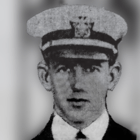 Lt. Byron J. Connell
Lt. Byron J. Connell.png) RM1/c Otis G. Stantz
RM1/c Otis G. Stantz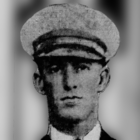 CPO Skiles R. Pope
CPO Skiles R. Pope MM1/c William M. Bowlin
MM1/c William M. Bowlin
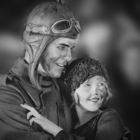 Cecil Ogden and Virginia Fry
Cecil Ogden and Virginia Fry Knute Erickson
Knute Erickson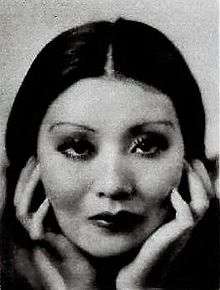 Toshia Mori
Toshia Mori
as Extra (uncredited)
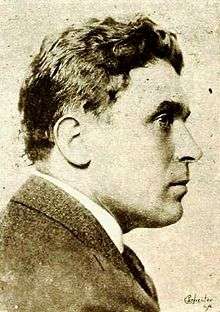 Robert Anderson
Robert Anderson
as Nuts Swanson Marcella Daly
Marcella Daly Mayor of San Francisco
Mayor of San Francisco
as himself Emory Johnson
Emory Johnson
Director & Producer
References
- "The Non-Stop Flight". www.tcm.com. Retrieved March 31, 2020.
- "Silent Era : Progressive Silent Film List". www.silentera.com.
- "The Non-Stop Flight". catalog.afi.com. The AFI Catalog of Feature Films. Retrieved March 31, 2020.
- Naval Aviation News. Chief of Naval Operations. 1988. pp. 11–15.
- Commander John Rodger's Non-Stop flight to Hawaii
- "PN-9 and Two of Crew to be in "Non-Stop Flight"". Motion Picture News. February 13, 1926. p. 787.
- "Government Generously Offers Use of Men and Destroyers". Bakersfield Morning Echo (Bakersfield, California). February 7, 1926. p. 8 – via newspapers.com.
- "Film Not Political Says Emory Johnson". The Billings Gazette (Billings, Montana). January 24, 1926. p. 19 – via newspapers.com.
- "Exhibitor Service is Keynote of FBO. Sales Polices". Moving Picture World. April 20, 1926. p. 719.
- "Non - Stop Flight Nears completion". Motion Picture News. March 27, 1926. p. 1379.
- "Entire Issue dedicated to the Fourth Commandment". Universal Weekly. Universal Pictures. October 30, 1926. pp. 46–89.
- "Motion Picture Producer here". The Fresno Morning Republican (Fresno, California). February 13, 1926. p. 11 – via newspapers.com.
- "The Non-Stop Flight / Emory Johnson [motion picture]". www.loc.gov/film-and-videos/. 1926.
- "Motion Pictures 1912 to 1939". Copyright Records - Motion Pictures. 1951. Cite journal requires
|journal=(help) - "NON-STOP FLIGHT". Film Daily. April 30, 1926. p. 16.
- "NON-STOP FLIGHT". Variety. July 7, 1926. p. 17.
- "Non - Stop Flight Nears Completion". Motion Picture News. April 27, 1926. p. 1836.
- "Straight From The Shoulder Reports". The Moving picture world. July 31, 1926. p. 293.
- "Straight From The Shoulder Reports". The Moving picture world. September 11, 1926. p. 115.
- Pierce, David. "The Survival of American Silent Films: 1912-1929" (PDF). Library Of Congress. Council on Library and Information Resources and the Library of Congress. Retrieved May 16, 2019.
- Lasky, Betty (1984). RKO The Biggest Little Major of Them All. Englewood Cliffs, NJ: Prentice-Hall. p. 14. ISBN 0-13-781451-8.
- "BOX OFFICE RECORD SECTION". Exhibitors Herald. Exhibitors Herald. September 25, 1926. p. 23.
- "F.B.O. Signs Emory Johnson for Eight Productions". Motion Picture News. New York, Motion Picture News, Inc. September–October 1923. p. 1185.
- "Emory Johnson leaves F.B.O." The Film Daily. April 18, 1926. p. 2.
- "Hollywood Studio Gossip". San Francisco Chronicle. June 4, 1926. p. 11. – via Genealogybank (subscription required)
- "John Rodgers-Commander, United States Navy". Arlington National Cemetery Website. Retrieved April 8, 2020.
- "ARMY & NAVY: Rodgers". www.time.com. September 6, 1926. Retrieved April 8, 2020.
- "American airplanes: Naval Aircraft Factory". Aerofiles. Retrieved October 3, 2007.
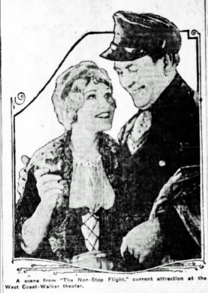
.jpg)



